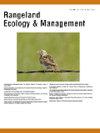通过鼠尾草指示物种的表现评估鼠尾草保护设计战略
IF 2.4
3区 环境科学与生态学
Q2 ECOLOGY
引用次数: 0
摘要
鼠尾草生态系统支持着一系列独特的物种,如标志性的大鼠尾草(Centrocercus urophasianus; sage-grouse),但其受到的人为压力也越来越大,如一年生草入侵、针叶林侵占、野火机制改变以及土地利用变化。我们研究了基于生态系统的鼠尾草保护框架、鼠尾草保护设计(SCD)战略以及相关的鼠尾草生态完整性(SEI)模型的能力,以确定鼠尾草(鼠尾草指示物种)的优先栖息地并对其进行排序。我们比较了 1996-2021 年间三个 SEI 类别中的松鼠数量趋势。然后,我们将这些趋势直接建模为与 SEI 基本相同的土地覆盖预测因子的函数,使用趋势估计中值重新划分鼠尾草的分布范围,并使用空间相关方法将我们的鼠尾草表现类别与 SEI 的类别进行比较。最后,我们将基于土地覆盖物的模型预测的松鸡状况类别与种群计数数据得出的经验趋势进行了比较。我们发现,SCD 和 SEI 是识别和排列鼠兔优先栖息地的有效工具。在 SEI 确定的核心区域,种群趋势保持稳定,但在较低的(即生长和其他)条件类别中,种群趋势有所下降。因此,在不成比例的较小区域内,核心区域所占的鼠兔总数量比例越来越大。我们的模型支持 SEI 提出的土地覆盖物与松鸡表现之间的一般功能关系。我们发现,在我们预测的松鸡种群表现类别、SEI 的条件类别以及从种群计数数据中得出的经验趋势之间存在着很强的空间一致性。我们的分析表明,以生态系统为基础的积极主动的保护鼠尾草生物群落的方法有助于优化有限的保护资源的回报和鼠尾草必生物种的利益,并有助于减少单一物种管理中固有的一些实际的和感知到的冲突。本文章由计算机程序翻译,如有差异,请以英文原文为准。
Evaluating the Sagebrush Conservation Design Strategy Through the Performance of a Sagebrush Indicator Species
Sagebrush ecosystems support a suite of unique species such as the emblematic greater sage-grouse (Centrocercus urophasianus; sage-grouse) but are under increasing pressure from anthropogenic stressors such as annual grass invasion, conifer encroachment, altered wildfire regimes, and land use change. We examined the ability of an ecosystem-based framework for sagebrush conservation, the sagebrush conservation design (SCD) strategy, and the associated model of sagebrush ecological integrity (SEI), to identify and rank priority habitats for sage-grouse, a sagebrush indicator species. We compared sage-grouse population trends from 1996–2021 across the three ranked SEI categories. We then modeled those trends directly as a function of the same landcover predictors underlying SEI, used the median trend estimates to recategorize the sage-grouse's range, and used spatial correlation methods to compare our sage-grouse performance categories with those of SEI. Finally, we compared the sage-grouse condition categories, predicted by our landcover-based model, to empirical trends derived from population count data. We found that the SCD and SEI were effective tools for identifying and ranking priority habitats for sage-grouse. Population trends were stable in the core areas identified by SEI but declining in the lower (i.e., growth and other) condition categories. As a result, core areas encompassed an increasingly larger share of the total sage-grouse population in a disproportionately smaller area. Our model supports the general functional relationships between landcover and sage-grouse performance suggested by SEI. We found strong spatial congruence between our categories of predicted sage-grouse population performance, the condition categories of SEI, and empirical trends derived from population count data. Our analysis demonstrates that proactive ecosystem-based approaches to the conservation of the sagebrush biome can help optimize the return on limited conservation resources and benefits for sagebrush obligate species and help reduce some of the real and perceived conflicts inherent in single-species management.
求助全文
通过发布文献求助,成功后即可免费获取论文全文。
去求助
来源期刊

Rangeland Ecology & Management
农林科学-环境科学
CiteScore
4.60
自引率
13.00%
发文量
87
审稿时长
12-24 weeks
期刊介绍:
Rangeland Ecology & Management publishes all topics-including ecology, management, socioeconomic and policy-pertaining to global rangelands. The journal''s mission is to inform academics, ecosystem managers and policy makers of science-based information to promote sound rangeland stewardship. Author submissions are published in five manuscript categories: original research papers, high-profile forum topics, concept syntheses, as well as research and technical notes.
Rangelands represent approximately 50% of the Earth''s land area and provision multiple ecosystem services for large human populations. This expansive and diverse land area functions as coupled human-ecological systems. Knowledge of both social and biophysical system components and their interactions represent the foundation for informed rangeland stewardship. Rangeland Ecology & Management uniquely integrates information from multiple system components to address current and pending challenges confronting global rangelands.
 求助内容:
求助内容: 应助结果提醒方式:
应助结果提醒方式:


